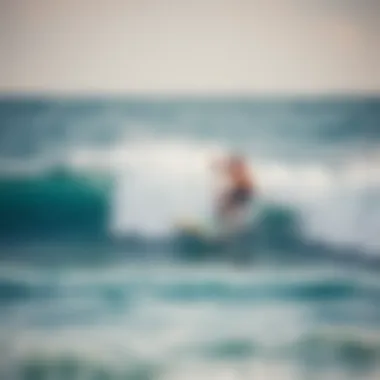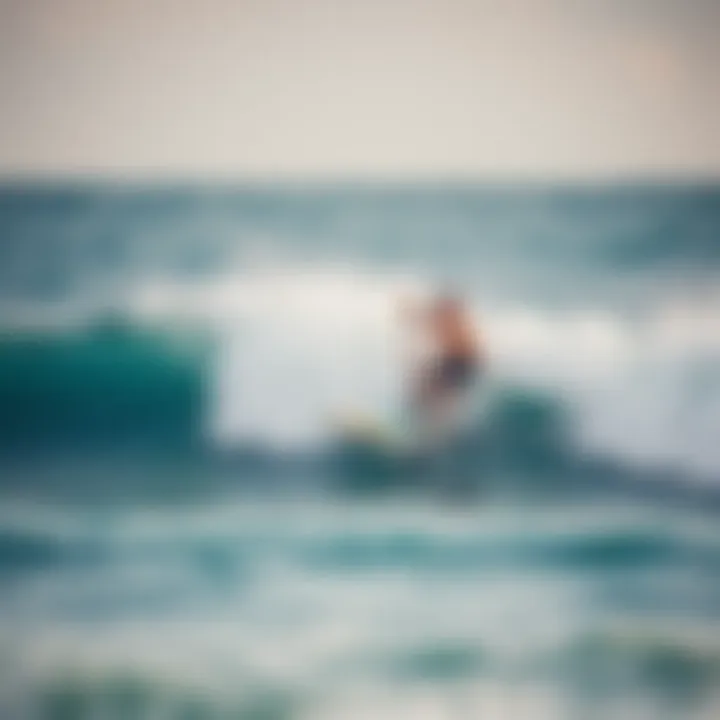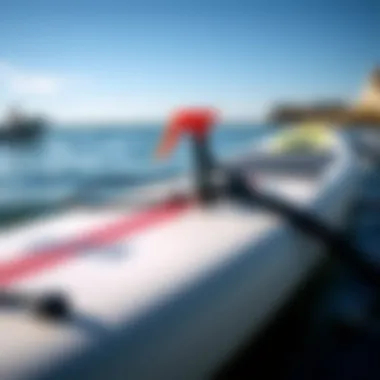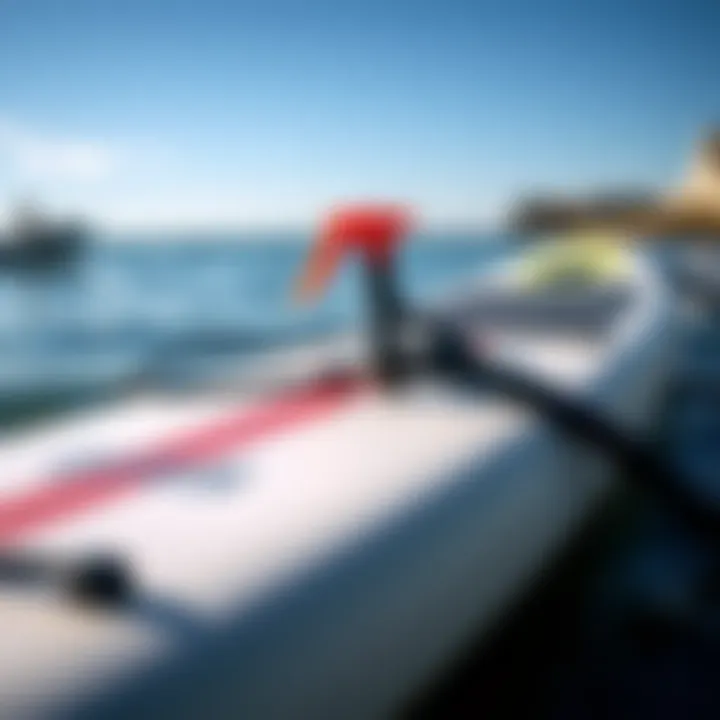Top Stand-Up Paddleboards for Surfing Reviewed


Intro
When we think about catching waves, stand-up paddleboarding for surfing comes to mind. It's not just about standing on a board; it’s about mastering the craft, embracing the elements, and finding that sweet spot where balance and performance meet. What distinguishes surf-specific paddleboards from regular SUPs is primarily their design. Surf SUPs are typically shorter, wider, and have a more pronounced rocker, allowing for quick turns and responsiveness on the waves. As this sport continues to gain traction among athletes and casual enthusiasts alike, knowing what to look for when choosing the best SUP for surfing becomes even more crucial.
In the world of stand-up paddleboarding, the right equipment can elevate your experience, ensuring you get the most from each outing. The goal of this article is to elucidate the features of various boards, the performance you might expect, and how to select the one that aligns best with your skill level and surfing needs. We aim to break down the complexities of design and construction while presenting concise recommendations for all kinds of surfers—whether you’re just starting out or ready to push your limits.
Tips and Techniques
As you step onto your paddleboard, it's essential to embrace both the thrill and the nuances that accompany the sport. Here are some pointers tailored to both beginners and advanced paddleboarders.
Beginner Tips for Watersports
- Start in Flat Water: Before venturing into the waves, get comfortable in calmer conditions. This helps build confidence and balance without the unpredictability of the surf.
- Check the Weather: Always keep an eye on the forecast. Wind, waves, and tide conditions can significantly affect your paddleboarding experience. If it looks like a perfect day to surf, that still might not be the best for a novice.
- Practice Paddling Technique: Focus on your stroke. A proper paddle technique involves using your core muscles rather than just your arms, which allows for more efficient power with less fatigue.
- Know Your Limits: Don’t get in over your head. Surfing is thrilling, but it also demands respect for the ocean. If the waves feel daunting, it’s okay to hold back and observe.
Advanced Techniques for Mastery
For those already well-versed in paddling, here are advanced strategies that can help you refine your skills:
- Timing the Waves: Understanding when to paddle hard and when to hold back can make a world of difference when catching a wave. Anticipating the swell requires practice but pays off when you ride the wave at its peak.
- Carving Turns: Move your weight slightly forward to make a tighter turn. To carve, lean the board in the direction you want to go, which will help control your trajectory as you cut through the water.
- Positioning: Where you stand on the board affects your performance. For sharp turns, stand a bit closer to the nose of the board; for stability, position yourself more towards the center.
"The sea is a great teacher, it challenges you to respond to its flow. Learn to listen, and you will write your own waves."
Safety and Gear
Safety should always be a priority when engaging in watersports. Here are recommendations and reminders to keep your ride enjoyable.
Essential Safety Practices
- Wear a PFD (Personal Flotation Device): It's not just a good idea; in some areas, it's a legal requirement. A well-fitted PFD provides safety without restricting movement.
- Buddy System: Whenever possible, paddle with someone. This adds an extra layer of safety, allowing for immediate help if something goes awry.
- Understanding Local Conditions: Familiarize yourself with the specific conditions of the beach or area you’re surfing. Currents, rocks, and other environmental factors can quickly turn safe situations risky.
Gear Reviews and Recommendations
Selecting the right gear enhances the overall experience, making your surfing endeavors much more enjoyable. Here are some boards that have gained popularity and praise.
Genuine Surf SUP Models:
- Starboard Whopper: Known for its stability and versatility, this board makes it easy for beginners and fun for experiences riders too.
- Naish Mana: A board that shines in surf and flat water, it's ideal for those looking for adaptability.
- BIC Sport 9’6”: A classic that delivers solid performance while being robust enough for less cautious paddlers.
In addition to boards, ensure good paddles, suitable apparel for the conditions, and perhaps a leash for safety. These elements are not just accessories; they are integral to a safe and rewarding surfing experience.
By embracing these tips, techniques, safety practices, and carefully selected gear, paddleboarding can transform from a simple pastime into an exhilarating adventure, unlocking the wonders that the ocean holds.
Understanding Stand-Up Paddleboards
Understanding stand-up paddleboards (SUPs) is crucial in navigating both the artistry of surfing and the science behind these versatile vessels. SUPs have evolved significantly from their humble beginnings, becoming a staple in water sports across the globe. With a myriad of options available, knowing the intricate details about SUP design and functionality will not only enrich your experience on waves but also help you to make informed decisions when purchasing or upgrading your gear.
Choosing SUPs designed specifically for surfing requires attention to specific elements such as dimensions, shape, and material. Each of these factors plays a vital role in how a board performs in various conditions, thereby impacting your overall surfing experience. Additionally, understanding stand-up paddleboards enhances appreciation for the craft involved in their design, which is often an interplay of art and technology. Investing time to learn about different SUP types can lift one's skills and help conquer waves with greater confidence.
History of Stand-Up Paddleboarding
Stand-up paddleboarding traces back to ancient cultures. Interestingly, it wasn’t always about having fun at the beach; many traditional forms of paddleboarding focused on fishing and transportation. For example, in Hawaii, native surfers would use large boards to paddle out to sea, catching fish along the way. This technique was viewed as a means of sustenance rather than a sport.
However, the evolution of stand-up paddleboarding as a recreational activity began in the mid-20th century. Many credit the modern resurgence to surf instructors in Waikiki, who used these boards to supervise students while providing lessons. From there, the concept gained traction and saw significant adaptations with reduced weight and enhanced designs suitable for various skill levels. Now, stand-up paddleboarding is a favored pastime worldwide, appealing to a diverse audience, whether they seek relaxation or adrenaline on the waves.
Mechanics of Surf SUP Design
When diving into the mechanics of surf SUP design, it's vital to grasp why certain shapes and materials excel in surf conditions. Wider boards offer stability, which is paramount for beginners, while narrower designs are found in more advanced models, allowing for swift carving and speed. Furthermore, the nose shape—be it pointed or rounded—influences how the board cuts through waves. A pointed nose helps in slicing through water, making it easier to paddle against currents, while a rounded nose might offer more buoyancy and stability.
Material choices also play an essential role in SUP performance. Common materials include epoxy and inflatable construction, with each offering unique benefits. Epoxy boards tend to be lighter and stiffer, providing quicker response times for sharp turns. Alternatively, inflatable boards offer the convenience of portability and storage, making them an attractive option for those who want to travel with their SUPs. Understanding these design nuances will empower riders to select SUPs that best fit their style and desired surf conditions.
Criteria for Selecting a Surf SUP
Selecting the right stand-up paddleboard (SUP) for surfing is more than just throwing down some cash on a flashy board. It’s a nuanced process that requires consideration of several cricitcal elements that can greatly affect performance and enjoyment on the water. This part delves into the unique factors that contribute to an effective surf SUP and why they matter. A thoughtful approach to these criteria ensures not only a better surfing experience but also enhances your skill level and comfort.
Dimensions and Shape
When you talk about dimensions and shape in surf SUPs, it's about balancing stability with speed. Unlike traditional longboards, surf SUPs are typically shorter and wider. This configuration allows a surfer to maneuver better and catch waves easily. However, the dimensions vary considerably. A longer board generally provides better tracking and stability, while a shorter board enhances maneuverability and carving ability.
If you’re just starting out, you might feel more comfortable with a board that's around 10 to 11 feet long, as it provides a sturdy platform from which to learn. Conversely, experienced surfers may benefit from a shorter board for tighter turns and surfing tricks.


Remember, an SUP should fit not only your height but also your ability level. A well-chosen shape leads to not just enhanced performance but also a more enjoyable experience on the waves.
Material Considerations
Material is another key aspect when selecting your surf SUP, impacting everything from buoyancy to durability. Boards can come crafted from different materials like foam, fiberglass, and epoxy, each with its pros and cons.
- Foam boards: These are light, durable, and less prone to breaking, making them an excellent choice for beginners.
- Fiberglass boards: Known for their performance and speed, these boards are perfect for intermediate to advanced surfers who want to optimize their ride.
- Epoxy boards: Lightweight yet strong, epoxy boards often offer a good blend of performance and durability.
Durability can dramatically influence your budget. A more durable board may require a greater upfront investment but could save you from frequent replacements and repairs in the long run. Understanding these materials, and how they'll perform over time, is essential for making an informed decision.
Weight and Stability
The weight of a board matters significantly, especially when you’re out in the water battling waves. Lighter boards may be easier to maneuver but can compromise stability in choppy conditions. Conversely, heavier boards provide greater stability but might be cumbersome for those aiming for rapid speed. Ideally, you want to find a balance that suits your personal surfing style.
Additionally, the stability of a board is affected by its width and design. A wider board will generally be more stable, which can be especially advantageous for beginners learning to stand and balance.
Before you make a purchase, consider where you will primarily be surfing. Different conditions call for different weights and designs. For instance, if you expect to encounter bigger waves, a heavier, stable board may serve you better than a lightweight model that could easily be tossed around.
The right board isn't just about price; it’s about understanding how the board will work for your specific surfing experience and local wave conditions.
As you make your decision, take into account these factors and envision how they will apply to your needs on the water. Selecting the right surf SUP requires careful thought about these criteria. Ultimately, your surfing adventures will become far more rewarding when you choose wisely.
Top Brands Offering Surf SUPs
When it comes to stand-up paddleboarding, particularly for surfing, selecting the right brand can greatly influence not just the quality of the board but also the overall experience on the water. The top brands have carved out niches for themselves through innovation, performance consistency, and a reputation that often precedes them in the surf community. These brands not only offer a variety of models tailored to different skill levels but also incorporate advanced technology and materials that optimize performance in diverse surf conditions.
Choosing a Surf SUP from a trusted brand means you can rely on the craftsmanship and design philosophy that has been tested and validated by surfers who demand the best from their equipment. Here are three brands that are at the forefront of this arena, each bringing their unique flair and emphasis to paddleboard design.
Innovation by Brand A
Brand A has made a name for itself due to its commitment to innovation. One of their hallmark products features a unique drop-stitch technology which enhances the rigidity and buoyancy of the board without adding unnecessary weight. This allows paddlers to catch waves with ease and make sharp turns without compromising stability. Their research and development team frequently collaborates with professional surfers and paddlers to gather real-world feedback, which translates directly into product improvements.
Moreover, eco-friendly materials are increasingly used in their production processes, aligning with a growing consciousness in the outdoor sports community about environmental sustainability. This not only appeals to eco-minded consumers but also sets a benchmark for others in the industry.
Performance of Brand B Models
Brand B is known for its performance. With a line of surf SUPs that boast excellent speed and maneuverability, they have crafted boards that excel in a variety of wave conditions. Surfers who tend to ride bigger waves often choose models from Brand B because they provide the kind of stability and control needed to navigate challenging surf.
Each model usually undergoes rigorous testing to optimize its rocker profile—the curvature of the board from nose to tail—which can significantly influence how the board interacts with waves. Surfers have reported improved responsiveness after using these boards, claiming that the quick turning capability and tracking make their sessions more enjoyable. This brand also offers extensive community support through resources like instructional videos and surf clinics.
Reputation of Brand
Brand C has built a reputation that speaks volumes in the surf SUP community, often regarded as the go-to for those beginning to delve into the world of stand-up paddle surfing. Their boards are recognized for being user-friendly, making them a popular choice for novices.
People often admire Brand C for its commitment to after-sales support and community engagement. They host events that foster a sense of community among paddlers and promote safe practices on the water. Strong customer service—whether through online support or local dealerships—ensures that users remain satisfied long after their purchase. Feedback often highlights not just the quality of the product but also the culture of support surrounding it.
In summary, while there are various brands available in the market, focusing on those recognized for their innovation, performance, and reputation can substantially elevate your surfing experience. Remember to consider not just the board specifications but also the values of the brand you choose, as this alignment can lead to greater satisfaction on your paddling journey.
Best Surf SUPs on the Market
When it comes to surfing, selecting the right stand-up paddleboard (SUP) can make or break your experience on the water. The market is flooded with options, each boasting unique features and benefits tailored for diverse water conditions and paddler abilities. Thus, knowing which surf SUPs rise above the rest is essential for anyone serious about their time on the waves.
A solid surf SUP must strike a balance between performance, stability, and comfort. Let’s break down why focusing on the best models matters:
- Performance Metrics: High-performing boards are designed for fast maneuvers and smooth gliding over waves. This allows surfers to catch waves with ease.
- Variety for Skill Levels: There’s no one-size-fits-all in surfing. Models cater to beginners as well as experienced surfers, so scouting out the best options can make a big difference in learning curves.
- Durability: Quality boards withstand the rigors of water, ensuring they last season after season. This is key for avid surfers who prioritize their gear investments.
- Community Involvement: Choosing popular models often exposes you to community events and competitions, enhancing your surfing experience.
Not only will we delve into the standout features of specific models, but we’ll also consider how different boards perform under widely varying conditions. The goal is to empower you with the knowledge to choose wisely, ensuring your next paddleboarding adventure is the best one yet.
Model A Review
Model A is a quintessential surf SUP that merges versatility with innovation. Designed for those who crave speed and agility, its lightweight construction doesn’t compromise on stability. With a width that allows for sharp turns and responsive handling, this board is a favorite among both amateur and seasoned surfers.
Key Features:
- Length: 11 feet, suitable for catching larger waves.
- Material: Made with a tough epoxy resin that reduces the chances of dings and conditions your board to last longer under duress.
- Fin System: Comes equipped with a thruster fin setup, which enhances the board's versatility.
Surfers note that Model A excels when it comes to paddling speed, making it ideal for quickly getting to the right spot. This model shines in choppy waters, providing a smooth ride where other boards might falter.
Model B Review


In contrast to Model A, Model B is specifically crafted for surfing in larger, more powerful waves. Slightly heavier, it boasts superior stability while allowing for impressive surf maneuvers.
Key Features:
- Length: 10’6” to balance ease of use and responsiveness.
- Construction: Utilizes a durable inflatable design which is portable and easy to store.
- Rocker Profile: Curved nose designed for slicing through choppy seas.
This board is often lauded for its stability, especially when faced with rugged conditions, providing the confidence necessary for surfers testing their limits. As a bonus, its inflated design allows for easier transportation and setup.
Model Review
Model C stands out for its adaptability across different environments. It seems to embrace the very nature of stand-up paddleboarding—freedom and exploration.
Key Features:
- Dimensions: 12 feet long, perfect for distance paddling as much as wave riding.
- Versatile Material: A unique blend of lightweight carbon and fiberglass enhances performance without sacrificing comfort.
- Multi-Fin Setup: Customizable fin options allow for fine-tuning based on your specific paddling style and water conditions.
What makes Model C a top contender is its adaptability to varying waters, making it a favorite among those who like to explore different surf spots without needing a whole quiver of boards. It effortlessly transitions from flat water to choppy surf without skipping a beat.
"The right SUP is not just a board; it is an extension of the surfer. Choose wisely to experience the waves at their best."
Evaluating Performance Metrics
When it comes to selecting the best stand-up paddleboards (SUPs) for surfing, it’s crucial to consider how each board performs in various conditions. The ability to understand and evaluate performance metrics is not just a matter of preference; it profoundly affects the overall surfing experience. These metrics include aspects like speed, maneuverability, stability, and adaptability. A paddleboard that excels in these areas can dramatically enhance your time on the water, making it essential to recognize how they play a role in your surfing adventures.
Speed and Maneuverability
Speed is of utmost importance when you’re out there catching waves. A board that can pick up speed quickly allows you to ride the wave efficiently, enhancing your surfing experience. Maneuverability, on the other hand, speaks to how easily the paddleboard can turn and respond to the wave's dynamics. For example, a streamlined design with a sharpened nose helps cut through the water, allowing for sharper turns. Without proper speed and maneuverability, you could find yourself struggling to get into the wave or missing opportunities to ride effectively.
- When choosing a SUP, consider the shape of the hull. A pointed nose typically provides better speed, while a wider tail can improve stability when turning.
- Rigid boards tend to be faster but may sacrifice some maneuverability. Finding a balance that fits your surfing style is key.
Stability in Waves
Stability plays a critical role when you’re navigating choppy waters or larger waves. A stable paddleboard will keep you from wiping out, grounding you as you tackle varying surf conditions. Stability is influenced by factors such as width, length, and construction materials of the board. Wider boards often provide better balance but may not allow for high-speed turns, while narrower boards may excel in maneuverability but require a steady stance.
- High-volume boards can maintain stability even in turbulent water, making them suitable for beginner surfers.
- Seasoned surfers may prefer a narrower design for enhanced performance, though it demands more balance and agility.
Adaptability on Different Waters
Not all water is created equal. Whether you’re surfing in a flat bay or battling the waves of the ocean, a paddleboard should adapt to different environments. An adaptable SUP allows you to transition seamlessly from calm waters to more challenging conditions, enhancing your overall skill development.
Look for boards that excel in versatility, meaning they can perform well in various water types without compromising performance. For instance, boards designed for surfing can still be effective in flat waters but typically require a little tweaking in technique.
"Versatility in a SUP can save you money and allow for a more comprehensive surfing experience with just one board."
- If you plan to paddle in rivers or lakes and surf in the ocean, choose a durable board that can withstand more than one environment.
- Pay attention to consumer reviews specific to various conditions. Insights from other users can help gauge how a board performs outside of typical scenarios.
Evaluating these performance metrics is pivotal for making an informed choice about a SUP. By understanding how speed, maneuverability, stability, and adaptability play into your surfing experience, you can choose a paddleboard that not only meets your needs but elevates your performance on the waves.
Techniques for Surfing with SUPs
Understanding the techniques involved in surfing with stand-up paddleboards (SUPs) is paramount for both beginners and seasoned surfers. Mastering these skills helps enhance the overall experience on the water, ensuring not just safety but also maximizing performance and enjoyment. SUP surfing brings together elements of balance, coordination, and strategy, making these techniques essential for riders looking to harness the waves effectively.
Paddling Techniques
Effective paddling is at the core of stand-up paddleboarding, directly affecting maneuverability and speed. When it comes to surfing with an SUP, paddling with precision integrates rhythm and strength. Here are key techniques to consider:
- Grip and Stance: Hold the paddle with a neutral grip. Your index finger should be near the top of the handle. Stand with feet shoulder-width apart, knees slightly bent. This stance allows for a stable base, which is critical when navigating ocean swells.
- Body Movement: Engage your core while paddling. To initiate a paddle stroke, rotate your torso and use your arms to drive the motion rather than just your shoulders. This creates a more powerful stroke, reducing fatigue over time.
- Sampling Waters: A good paddler knows when to power through and when to glide. Identify slower strokes to maintain balance while anticipating the waves.
Practicing these paddling techniques not only aids in managing board speed but also provides greater directional control, allowing surfers to catch and ride waves effectively.
Navigating Waves
Surfing isn’t just about catching waves; it's about how you interact with them. Knowing how to navigate waves while on a SUP involves understanding both the ocean and your equipment. Here’s what to keep in mind:
- Timing and Positioning: Anticipate when a wave will break. Position yourself accordingly, just beyond where the wave lifts. Timing is everything; a late take-off might flip your board instead of riding the wave.
- Paddle for Momentum: When you see a wave approaching, paddle hard in its direction. A good burst of speed can not only help catch the wave but also keep you stable as it begins to break.
- Angle Your Board: Depending on the wave's direction, angling your board correctly is crucial. Either point directly towards the shore or angle it to glide along the wave's face, depending on the surf conditions.
With practice, you’ll find your rhythm in navigating waves, which is a blend of instinct and technical skill.
Safety Considerations


SUP surfing brings about thrill but also demands respect for the water and one’s surroundings. Several safety considerations make sure that your time on the board is both enjoyable and secure:
- Wear a Personal Flotation Device (PFD): The ocean can be unpredictable. Wearing a PFD ensures you stay afloat in case of a fall or strong currents. This is particularly crucial in spots where the surf is rough.
- Know Your Limits: Understand your skill level and avoid pushing your boundaries in challenging conditions. Opting for calmer waters or smaller waves when you’re just starting is wise.
- Awareness: Always keep an eye on fellow surfers and swimmers around you. Surf etiquette applies; knowing when to yield can prevent injuries and accidents.
"Safety doesn’t happen by accident; it’s a conscious choice you make."
Staying safe while enjoying surfing with a SUP is the key to developing your skill without the worry of serious mishaps. With the right techniques and attentiveness, your journeys on the water can be fulfilling and exhilarating.
Maintaining Your Surf SUP
Taking care of your stand-up paddleboard, especially one designed for surfing, is just as crucial as picking the right model. A well-maintained SUP doesn’t just sail smoothly over waves; it also prolongs the life of your gear and ensures your safety while enjoying time on the water. You wouldn't drive a car without regular maintenance - why treat your paddleboard any differently?
Understanding how to care for your SUP can prevent wear and tear from the onset, not to mention save you a considerable amount of money in repairs or replacements down the line. Hence, focusing on two primary elements: cleaning and care and storage practices, can forge a path to enhanced performance and enjoyment.
Cleaning and Care
Cleaning your paddleboard isn’t just about looking good; it’s about protecting its materials and extending its usability. Saltwater and sand can be particularly tough adversaries on any surf SUP. Here are a few points to keep in mind:
- Rinse After Use: Always rinse your board with fresh water after surfing. This practice helps remove any salt, sand, and debris that can cause scratches or degrade materials over time.
- Use Mild Soap: For a deeper clean, using a gentle soap can be beneficial, but avoid abrasive cleaners. Using a soft sponge will do the trick without damaging the surface.
- Pay Attention to the Fins: Fins can trap debris and sand, creating performance issues. Make sure to check and clean them regularly.
- Regular Inspections: Check for any dents, cracks, or delamination. Left unattended, these issues can grow and become costly repairs.
"Regular cleaning and maintenance transform a board into a beloved companion for countless waves."
Incorporate these practices into your post-surf routine, and you'll see the difference in your paddleboard’s performance and lifespan.
Storage Practices
After a day on the water, where you store your surf SUP can also impact its longevity. Here are some key considerations for storage:
- Keep it Indoors: Whenever possible, store your board indoors, away from direct sunlight. UV rays can weaken the materials, leading to costly repairs.
- Use a Board Bag: A padded board bag provides an extra layer of protection against scratches and dings.
- Avoid Heavy Weights: Never pile heavy objects on top of your board while storing it. This pressure can warp the shape and compromise its performance.
- Positioning Matters: If you have to store it vertically, ensure that the fins are well protected. Leaning it against a wall can lead to unwelcome stress on the structure.
By following these simple storage guidelines, you not only maintain your investment but also keep your paddleboard ready for the next wave, ensuring that it's always in prime condition for your surfing escapades.
Adapting to Local Conditions
When it comes to stand-up paddleboarding for surfing, the local conditions can make or break your experience. Choosing the right SUP involves more than just picking a model; it requires keen awareness and adaptability to the unique features of the waves and the environment you'll be paddling in. Having this knowledge can elevate your performance and ensure a safer, more enjoyable venture into the surf.
Understanding Wave Types
Waves vary widely, each with its characteristics influenced by geography, ocean currents, and even the weather. Therefore, a fundamental understanding of wave types is crucial for any paddleboard surfer. Here are some of the most common wave types you should familiarize yourself with:
- Beach Breaks: These occur where the waves break over a sandy bottom. They can be unpredictable, often changing in size and shape. This type requires good maneuverability and quick reflexes, best suited to boards that are shorter, allowing for nimble turns.
- Point Breaks: These waves break along a point of land, offering longer rides. A paddleboard with more stability is essential here, since you’ll want to maintain your position longer. Width and volume become key factors, as they help with early plane-age when catching waves.
- Reef Breaks: Breaking over coral or rocks, these waves can be powerful and fast. A resilient paddleboard that can withstand intense impacts is necessary. However, be cautious; novice surfers should avoid this type of break until they are more seasoned.
- Condition Variability: Recognize that waves can change by the hour or even minute due to wind and tide shifts. Checking local surf reports and observing local surfers can provide essential insights into how conditions might evolve throughout the day.
"In surfing, as in life, timing is everything. Understanding the local environment can turn a mediocre session into a once-in-a-lifetime ride."
Weather Influences
Weather conditions play a critical role in the surfing experience with SUPs. Wind, temperature, and precipitation can heavily impact wave quality, as well as personal comfort and safety. Here’s what to keep an eye on:
- Wind Direction and Speed: Offshore winds can clean up wave faces, making them ideal for surfing. Conversely, onshore winds can create choppy conditions, which are less favorable. A solid grasp of how wind interacts with local wave formations can greatly enhance your paddleboarding session.
- Temperature Considerations: Knowing the water temperature is not just about comfort, but also about safety. Colder waters might require a wetsuit. On the other hand, if conditions are too warm, consider sun protection strategies, such as applying waterproof sunscreen to avoid sunburns.
- Rainfall and Visibility: While light rain can refresh the atmosphere, heavy rain can wash pollutants into the water and impact visibility. Always check local advisories if sudden rain begins; safety should never be compromised.
- Seasonal Changes: Different seasons can bring varying swell sizes and patterns. Training during specific months for local conditions can make all the difference in your skills. Familiarizing yourself with seasonal weather patterns can prepare you for optimal surfing conditions
In summary, adapting your SUP strategy to local conditions can significantly enhance your surfing experience. The knowledge of wave types and understanding how weather affects these waves will not just help in choosing the right gear but will also improve your skills on the water. Being a versatile and informed surfer allows for a better experience and, importantly, spares you from potential hazards.
Community and Culture of Surf SUP
Stand-up paddleboarding, particularly in surfing scenarios, goes well beyond just the thrill of riding waves. The community and culture surrounding surf SUP play a vital role in shaping the experience for enthusiasts. This culture is not merely built on the act of paddling through water; it is entrenched in shared passions, camaraderie, and an ethos of respect for the ocean and fellow paddleboarders.
Engagement in this community fosters a strong sense of belonging among paddlers. Individuals often band together, sharing tips, tricks, and stories from their time on the water. One notable aspect is the way seasoned surfers mentor newcomers. The social element cannot be ignored; friendships develop over shared experiences, ranging from early morning paddles to competitive events. Additionally, these strong ties help elevate the sport, creating a network of support that encourages both improvement and safety on the water.
Social Aspects of SUP
The social dynamics of surf SUP are an intricate tapestry of interactions among diverse participants. From enthusiastic newbies to veteran surfers, differences in skill and experience do not create divides but rather instill a vibrant atmosphere of learning and growth. Surf SUP trips often turn into weekend getaways, with groups planning trips that include not only paddling but also camping and beach barbecues, fostering a buoyant spirit of community.
Moreover, these gatherings often serve as platforms for sharing knowledge about local surfing spots, safety practices, and environmental conservation. This reflects a strong communal belief in protecting coastlines and aquatic environments for future generations. The emphasis on sustainability nurtures a sense of environmental stewardship among surfers.
Networking is another essential feature of the social aspect of surf SUP. Paddlers often form connections that extend into professional realms as well. Coaches, travel agents, and bloggers frequently interact, sharing insights that can lead to collaborations. These networks often become instrumental in promoting events, workshops, and competitions that benefit all involved.
Events and Competitions
Events and competitions are the soul of surf SUP culture, drawing in participants and spectators alike. These gatherings range from local meets at beaches to larger-scale national and even international competitions. Events serve dual purposes: they showcase paddlers’ skills and provide an avenue for community building. The excitement of competition can ignite the passion for the sport, spurring newcomers to take the plunge into the world of surf SUP.
Events like the Stand Up World Series attract top talent, where paddleboarders from various backgrounds clash in exhilarating contests. These competitions not only push athletes to improve but also raise the profile of surf SUP, thereby drawing in more participants. Beyond being a competitive sport, events often come with workshops led by professional paddlers, providing the perfect opportunity for attendees to refine their techniques and learn from the best.
Another key aspect of these events is that they frequently benefit local causes or charities, emphasizing the importance of giving back to the community. This connection illustrates how the community culture of surf SUP is intertwined with broader societal values, highlighting a dedication to contributing positively to the environment and local culture.
In summary, the community and culture of surf SUP present a rich narrative woven from shared experiences, social connections, and competitive spirit. This tapestry not only enhances the individual experiences of paddlers but helps perpetuate the growth and evolution of the sport.















